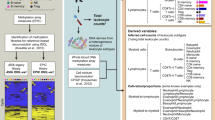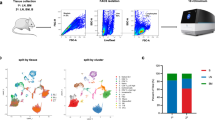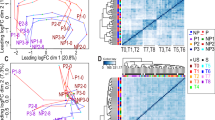Abstract
DNA can cross the cell membrane by natural means, but the functional relevance of this phenomenon has not been fully elucidated. Here, we analyzed spontaneous transgenesis of human B cells using plasmid DNA coding for a functional immunoglobulin (Ig) heavy chain gene under the control of a B-cell-specific promoter. Using polymerase chain reaction (PCR), reverse transcriptase-PCR, and flow cytometry in combination, spontaneous transgenesis was documented in Burkitt's lymphoma cell lines, Epstein–Barr virus-transformed cell lines, and peripheral blood B lymphocytes of the mature naïve phenotype (IgM+/IgD+/CD27−). By immunoelectron microscopy, the internalized DNA was seen in the lysosomes/late endosomes and in the cytosol proximal to the nucleus. Importantly, spontaneously transgenic B cells processed and presented to major histocompatibility complex (MHC)-restricted T lymphocytes a peptide expressed in the transgenic product. This is the first demonstration that primary B lymphocytes possess a program for the spontaneous internalization of DNA, which in turn imparts the cell with new immunological functions. As spontaneous transgenesis is obtained using a nonviral vector, does not require prior cell activation, and is not associated with chromosomal integration, the findings reported here open new possibilities for genetic manipulations of mature naïve B lymphocytes for therapy and vaccination.
This is a preview of subscription content, access via your institution
Access options
Subscribe to this journal
Receive 6 print issues and online access
$259.00 per year
only $43.17 per issue
Buy this article
- Purchase on SpringerLink
- Instant access to full article PDF
Prices may be subject to local taxes which are calculated during checkout








Similar content being viewed by others
References
Friedmann T . Progress toward human gene therapy. Science 1989; 244: 1275–1281.
Gregoriadis G . Genetic vaccines: strategies for optimization. Pharm Res 1998; 15: 661–670.
Cibelli JB, Lanza RP, West MD, Ezzell C . The first human cloned embryo. Sci Am 2002; 286: 44–51.
Wilmut I et al. Viable offspring derived from fetal and adult mammalian cells. Nature 1997; 385: 810–813.
Willard HF . Genomics and gene therapy. Artificial chromosomes coming to life. Science 2000; 290: 1308–1309.
Grimes BR et al. Stable gene expression from a mammalian artificial chromosome. EMBO Rep 2001; 2: 910–914.
Wu GY et al. Receptor-mediated gene delivery in vivo. Partial correction of genetic albuminemia in Nagase rats. J Biol Chem 1991; 266: 14338–14342.
Engelhardt JF et al. Direct gene transfer of human CFTR into human bronchial epithelia of xenografts with E1-deleted adenoviruses. Nat Genet 1993; 4: 27–34.
Luo D, Saltzman WM . Synthetic DNA delivery systems. Nat Biotechnol 2000; 18: 33–37.
Chan DC, Kim PS . HIV entry and its inhibition. Cell 1998; 93: 681–684.
Klasse PJ, Bron R, Marsh M . Mechanisms of enveloped virus entry into animal cells. Adv Drug Deliv Rev 1998; 34: 65–91.
Sauer FG et al. Bacterial pili: molecular mechanisms of pathogenesis. Curr Opin Microbiol 2000; 3: 65–72.
Hill M . The uptake of deoxyribonucleic acid released from damaged cells in tissue cultures. Exp Cell Res 1967; 45: 533–549.
Robins AB, Taylor DM . Nuclear uptake of exogenous DNA by mammalian cells in culture. Nature 1968; 217: 1228–1231.
Ayad SR, Fox M . DNA uptake by a mutant strain of lymphoma cells. Nature 1968; 220: 35–38.
Wigler M et al. Transfer of purified herpesvirus thymidine kinase gene to cultured mouse cells. Cell 1977; 11: 223–232.
Brackett BG, Baranska W, Sawicki W, Koprowski H . Uptake of heterologous genome by mammalian spermatozoa and its transfer to ova through fertilization. Proc Natl Acad Sci USA 1971; 68: 353–357.
Wolff JA et al. Direct gene transfer into mouse muscle in vivo. Science 1990; 247: 1465–1468.
Tang D, DeVit M, Johnston SA . Genetic immunization is a simple method for eliciting an immune response. Nature 1992; 356: 152–154.
Ulmer JB et al. Heterologous protection against influenza by injection of DNA encoding a viral protein. Science 1993; 259: 1745–1749.
Dupuis M et al. Distribution of DNA vaccines determines their immunogenicity after intramuscular injection in mice. J Immunol 2000; 165: 2850–2858.
Sollazzo M, Billetta R, Zanetti M . Expression of an exogenous peptide epitope genetically engineered in the variable domain of an immunoglobulin: implications for antibody and peptide folding. Protein Eng 1990; 4: 215–220.
Rivoltini L et al. Induction of tumor-reactive CTL from peripheral blood and tumor-infiltrating lymphocytes of melanoma patients by in vitro stimulation with an immunodominant peptide of the human melanoma antigen MART-1. J Immunol 1995; 154: 2257–2265.
Xiong S, Gerloni M, Zanetti M . Engineering vaccines with heterologous B and T cell epitopes using immunoglobulin genes. Nat Biotech 1997; 15: 882–886.
Beltinger C et al. Binding, uptake, and intracellular trafficking of phosphorothioate-modified oligodeoxynucleotides. J Clin Invest 1995; 95: 1814–1823.
Sollazzo M et al. Molecular characterization of the VH region of murine autoantibodies from neonatal and adult BALB/c mice. Eur J Immunol 1989; 19: 453–457.
Klein U, Rajewsky K, Kuppers R . Human immunoglobulin (Ig)M+IgD+ peripheral blood B cells expressing the CD27 cell surface antigen carry somatically mutated variable region genes: CD27 as a general marker for somatically mutated (memory) B cells. J Exp Med 1998; 188: 1679–1689.
Frazer JK, Capra JD . Immunoglobulins: structure and function. In: Paul WE (ed). Fundamental Immunology 4th edn. Lippincott-Raven Publishers: Philadelphia, 1999, pp 37–74.
Fra AM et al. Quality control of ER synthesized proteins: an exposed thiol group as a three-way switch mediating assembly, retention and degradation. EMBO J 1993; 12: 4755–4761.
Mancini R et al. Degradation of unassembled soluble Ig subunits by cytosolic proteasomes: evidence that retrotranslocation and degradation are coupled events. FASEB J 2000; 14: 769–778.
Yewdell JW, Bennink JR . Cell biology of antigen processing and presentation to major histocompatibility complex class I molecule-restricted T lymphocytes. Adv Immunol 1992; 52: 1–123.
Yakubov LA et al. Mechanism of oligonucleotide uptake by cells: involvement of specific receptors? Proc Natl Acad Sci USA 1989; 86: 6454–6458.
Loke SL et al. Characterization of oligonucleotide transport into living cells. Proc Natl Acad Sci USA 1989; 86: 3474–3478.
Budker V et al. Hypothesis: naked plasmid DNA is taken up by cells in vivo by a receptor-mediated process. J Gene Med 2000; 2: 76–88.
Gasparro FP et al. Cell membrane DNA: a new target for psoralen photoadduct formation. Photochem Photobiol 1990; 52: 315–321.
Goodarzi G, Watabe M, Watabe K . Binding of oligonucleotides to cell membranes at acidic pH. Biochem Biophys Res Commun 1991; 181: 1343–1351.
Vlassov VV, Balakireva LA, Yakubov LA . Transport of oligonucleotides across natural and model membranes. Biochim Biophys Acta 1994; 1197: 95–108.
Benimetskaya L et al. Mac-1 (CD11b/CD18) is an oligodeoxy-nucleotide-binding protein. Nat Med 1997; 3: 414–420.
Bennett RM, Gabor GT, Merritt MM . DNA binding to human leukocytes. Evidence for a receptor-mediated association, internalization, and degradation of DNA. J Clin Invest 1985; 76: 2182–2190.
Bennet RM et al. The production and characterization of murine monoclonal antibodies to a DNA receptor on human leukocytes. J Immunol 1988; 140: 2937–2942.
Siess DC et al. A human gene coding for a membrane-associated nucleic acid-binding protein. J Biol Chem 2000; 275: 33655–33662.
Hemmi H et al. A Toll-like receptor recognizes bacterial DNA. Nature 2000; 408: 740–745.
Bauer S et al. Human TLR9 confers responsiveness to bacterial DNA via species-specific CpG motif recognition. Proc Natl Acad Sci USA 2001; 98: 9237–9242.
Ahmad-Nejad P et al. Bacterial CpG-DNA and lipopoly-saccharides activate Toll-like receptors at distinct cellular compartments. Eur J Immunol 2002; 32: 1958–1968.
Chuang TH et al. Toll-like receptor 9 mediates CpG-DNA signaling. J Leukocyte Biol 2002; 71: 538–544.
Roche PA et al. Cell surface HLA-DR-invariant chain complexes are targeted to endosomes by rapid internalization. Proc Natl Acad Sci USA 1993; 90: 8581–8585.
Amigorena S, Drake JR, Webster P, Mellman I . Transient accumulation of new class II MHC molecules in a novel endocytic compartment in B lymphocytes. Nature 1994; 369: 113–120.
Thery C et al. MHC class II transport from lysosomal compartments to the cell surface is determined by stable peptide binding, but not by the cytosolic domains of the alpha- and beta-chains. J Immunol 1998; 161: 2106–2113.
Filaci G et al. Double-stranded deoxyribonucleic acid binds to HLA class II molecules and inhibits HLA class II-mediated antigen presentation. Eur J Immunol 1998; 28: 3968–3979.
Gruenberg J . The endocytic pathway: a mosaic of domains. Nat Rev Mol Cell Biol 2001; 2: 721–730.
Miaczynska M, Zerial M . Mosaic organization of the endocytic pathway. Exp Cell Res 2002; 272: 8–14.
Mahnke K et al. The dendritic cell receptor for endocytosis, DEC-205, can recycle and enhance antigen presentation via major histocompatibility complex class II-positive lysosomal compartments. J Cell Biol 2000; 151: 673–684.
Witmer-Pack MD et al. Tissue distribution of the DEC-205 protein that is detected by the monoclonal antibody NLDC-145. II. Expression in situ in lymphoid and nonlymphoid tissues. Cell Immunol 1995; 163: 157–162.
Engering A et al. The dendritic cell-specific adhesion receptor DC-SIGN internalizes antigen for presentation to T cells. J Immunol 2002; 168: 2118–2126.
McKay PF et al. The gp200-MR6 molecule which is functionally associated with the IL-4 receptor modulates B cell phenotype and is a novel member of the human macrophage mannose receptor family. Eur J Immunol 1998; 28: 4071–4083.
Perucho M, Wigler M . Linkage and expression of foreign DNA in cultured animal cells. Cold Spring Harb Symp Quant Biol 1981; 45: 829–838.
Kamiya H, Tsuchiya H, Yamazaki J, Harashima H . Intracellular trafficking and transgene expression of viral and non-viral gene vectors. Adv Drug Deliv Rev 2001; 52: 153–164.
Temin HM . Overview of biological effects of addition of DNA molecules to cells. J Med Virol 1990; 31: 13–17.
Lanzavecchia A . Antigen-specific interaction between T and B cells. Nature 1985; 314: 537–539.
Kovacsovics-Bankowski M, Rock KL . A phagosome-to-cytosol pathway for exogenous antigens presented on MHC class I molecules. Science 1995; 267: 243–246.
Rock KL, Gamble S, Rothstein L . Presentation of exogenous antigen with class I major histocompatibility complex molecules. Science 1990; 249: 918–921.
Pfeifer JD et al. Phagocytic processing of bacterial antigens for class I MHC presentation to T cells. Nature 1993; 361: 359–362.
Rodriguez A et al. Selective transport of internalized antigens to the cytosol for MHC class I presentation in dendritic cells. Nat Cell Biol 1999; 1: 362–368.
Castellino F et al. Receptor-mediated uptake of antigen/heat shock protein complexes results in major histocompatibility complex class I antigen presentation via two distinct processing pathways. J Exp Med 2000; 191: 1957–1964.
Sutkowski N et al. A murine model for B-lymphocyte somatic cell gene therapy. Proc Natl Acad Sci USA 1994; 91: 8875–8879.
Zambidis ET, Kurup A, Scott DW . Genetically transferred central and peripheral immune tolerance via retroviral-mediated expression of immunogenic epitopes in hematopoietic progenitors or peripheral B lymphocytes. Mol Med 1997; 3: 212–224.
Hogan KT, Brown SL . Localization and characterization of serologic epitopes on HLA-A2. Hum Immunol 1992; 33: 185–192.
Morrison SL, Johnson MJ, Herzenberg LA, Oi VT . Chimeric human antibody molecules:mouse antigen-binding domains with human constant region domains. Proc Natl Acad Sci USA 1984; 81: 6851–6855.
Sollazzo M et al. Structural definition by antibody engineering of an idiotypic determinant. Protein Eng 1990; 3: 531–539.
Xiong S, Gerloni M, Zanetti M . In vivo role of B lymphocytes in somatic transgene immunization. Proc Natl Acad Sci USA 1997; 94: 6352–6357.
Fiocca R et al. Release of Helicobacter pylori vacuolating cytotoxin by both a specific secretion pathway and budding of outer membrane vesicles. Uptake of released toxin and vesicles by gastric epithelium. J Pathol 1999; 188: 220–226.
Fiocca R et al. Widespread expression of intestinal markers in gastric carcinoma: a light and electron microscopic study using BD-5 monoclonal antibody. J Clin Pathol 1988; 41: 178–187.
Temponi M et al. Characterization of anti-HLA class II monoclonal antibody LGII-612.14 reacting with formalin fixed tissues. J Immunol Methods 1993; 161: 239–256.
Minev B et al. Cytotoxic T cell immunity against telomerase reverse transcriptase in humans. Proc Natl Acad Sci USA 2000; 97: 4796–4801.
Acknowledgements
We are thankful to Drs MG Farquhar, W Loomis, and J Urbain for critical reading of the manuscript and their helpful suggestions. We also thank G Almanza and I LacKamp (Cosmo Bioscience) for their help in the performance of PCR work and A Necchi (University of Pavia) for assistance with the electron microscopy. This work was supported in part by a grant from the School of Medicine of the University of California, San Diego, and NIH Grants RO1CA77427 and R21AI49771 (to MZ). GF was a recipient of a short-term mobility grant from Consiglio Nazionale delle Ricerche and from the Compagnia di SanPaolo (Italy).
Author information
Authors and Affiliations
Rights and permissions
About this article
Cite this article
Filaci, G., Gerloni, M., Rizzi, M. et al. Spontaneous transgenesis of human B lymphocytes. Gene Ther 11, 42–51 (2004). https://doi.org/10.1038/sj.gt.3302132
Received:
Accepted:
Published:
Issue date:
DOI: https://doi.org/10.1038/sj.gt.3302132
Keywords
This article is cited by
-
Properties of internalization factors contributing to the uptake of extracellular DNA into tumor-initiating stem cells of mouse Krebs-2 cell line
Stem Cell Research & Therapy (2016)
-
Microfluidic squeezing for intracellular antigen loading in polyclonal B-cells as cellular vaccines
Scientific Reports (2015)
-
Early and repeated IgG1Fc-pCons chimera vaccinations (GX101) improve the outcome in SLE-prone mice
Clinical and Experimental Medicine (2015)
-
Telomerase immunity from bench to bedside: round one
Journal of Translational Medicine (2007)



